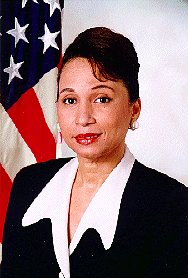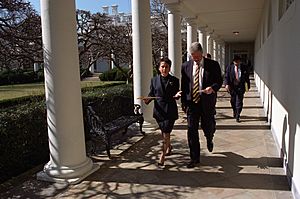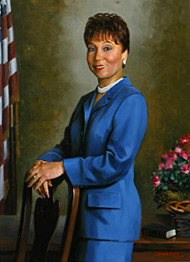Alexis Herman facts for kids
Quick facts for kids
Alexis Herman
|
|
|---|---|

Official portrait, 1998
|
|
| 23rd United States Secretary of Labor | |
| In office May 1, 1997 – January 20, 2001 |
|
| President | Bill Clinton |
| Deputy | Kathryn O. Higgins |
| Preceded by | Robert Reich |
| Succeeded by | Elaine Chao |
| 12th Director of the Office of Public Liaison | |
| In office January 20, 1993 – February 7, 1997 |
|
| President | Bill Clinton |
| Preceded by | Cecile B. Kremer |
| Succeeded by | Maria Echaveste |
| 8th Director of the Women's Bureau | |
| In office April 4, 1977 – January 20, 1981 |
|
| President | Jimmy Carter |
| Preceded by | Carmen Maymi |
| Succeeded by | Lenora Alexander |
| Personal details | |
| Born |
Alexis Margaret Herman
July 16, 1947 Mobile, Alabama, U.S. |
| Died | April 25, 2025 (aged 77) Washington, D.C., U.S. |
| Political party | Democratic |
| Spouse |
Charles Franklin
(m. 2000; died 2014) |
| Relatives | Alex Herman (father) |
| Education |
|
Alexis Margaret Herman (July 16, 1947 – April 25, 2025) was an important American leader. She worked for the government and helped many people. She was the Secretary of Labor for President Bill Clinton from 1997 to 2001. She was the first Black American to have this job. Before that, she helped the President connect with different groups of people.
Alexis grew up in Mobile, Alabama. After college, she worked to create better job chances for Black workers and women. She then joined President Jimmy Carter's team. There, she led the Women's Bureau in the Labor Department. She became very active in the Democratic Party. She worked on campaigns for Jesse Jackson and later became a top aide for the Democratic National Committee. She joined President Bill Clinton's group of advisors in 1997.
After the 2000 presidential election, Alexis Herman continued to be involved in politics. She also worked in the business world. She served on the boards of big companies like Coca-Cola and Toyota.
Contents
Early Life and Education
Alexis Herman was born on July 16, 1947, in Mobile, Alabama. Her father, Alex Herman, was a politician, and her mother, Gloria Caponis, was a teacher. She grew up in a Catholic family. Her father was the first Black ward leader in Alabama. She shared stories about challenges her father faced when she was young.
When Alexis was a child in Mobile, schools were still separated by race. Her parents chose to send her to parochial school. This included Heart of Mary High School. They wanted her to learn from a diverse group of teachers, including white nuns and priests.
As a sophomore, she was suspended from school. This happened because she questioned why Black students were not allowed in religious events. After a week of protests from other Black families, she was allowed back into school.
After high school, Alexis went to Edgewood College in Madison, Wisconsin. She also attended Spring Hill College in Mobile. She then moved to Xavier University of Louisiana in New Orleans. There, she joined the Delta Sigma Theta sorority. She earned a Bachelor of Arts degree in Sociology in 1969.
Alexis Herman's Career Journey
After college, Alexis Herman returned to Mobile. She helped to integrate the local parochial schools, including her own former school. She then worked as a social worker for Catholic Charities USA in Pascagoula, Mississippi. In this role, she pushed for the city's shipyard to train unskilled Black workers. After Pascagoula, Herman moved to Atlanta, Georgia. She became a director for the Southern Regional Council's Black Women's Employment Program. This program aimed to help minority women get management or technical jobs.
Later, she worked at RTP, a consulting firm in New York. There, she led programs that created apprenticeships for women in new types of jobs. At RTP, she met Ray Marshall. When Jimmy Carter became president in 1977, he and his new Labor Secretary, Ray Marshall, asked Alexis to lead the Labor Department's Women's Bureau. At 29, she was the youngest person to hold this job. Her goal was to improve business opportunities for women. She encouraged companies to hire more minority women. Big companies like Coca-Cola, Delta Airlines, and General Motors made increasing diversity a top goal in their hiring.
In 1981, after the Carter administration ended, Alexis Herman started her own consulting firm, A.M. Herman & Associates. Her firm helped companies with marketing and management. This included creating training programs and business plans. She also managed the convention teams for Jesse Jackson's presidential campaigns in 1984 and 1988. Her work for Jackson's campaign led her to become chief of staff for Democratic National Committee Chairman Ronald H. Brown. Later, she was vice chair of the 1992 Democratic National Convention.
Leading the Office of Public Liaison
After Bill Clinton won the 1992 Presidential election, Alexis Herman became a deputy director for his transition team. President Clinton then chose her to lead the White House Office of Public Liaison. In this role, she managed the administration's relationships with different interest groups. She often organized informal dinners to promote White House plans or to help key groups. She gained support from groups like the NAACP and the Congressional Black Caucus through her outreach. Herman also earned the respect of business leaders. She helped gain support for the Clinton Administration's trade deal, the North American Free Trade Agreement.
During her time as director, Commerce Secretary Ronald Brown, her former boss, died in a plane crash. As director, Alexis Herman helped arrange public and private events for grieving. This tragedy made her bond with President Clinton even stronger, as they both were close to Brown.
Serving as Secretary of Labor
In 1996, President Clinton announced he would nominate Alexis Herman to be Secretary of Labor. She would replace Robert Reich. Labor unions supported her nomination, even though they had favored other candidates. Her confirmation by the U.S. Senate was delayed twice. The first delay was due to questions about her role in White House events used for fundraising. The second was because Senate Republicans would not allow a vote on her nomination. This was part of their opposition to a proposed rule about federal construction projects, which Clinton eventually dropped. After these delays, the Senate Labor Committee held her hearing on March 18, 1997. On April 30, 1997, the Senate confirmed her by a vote of 85–13. Alexis Herman was sworn in on May 9, 1997. She became the first Black American and the fifth woman to hold this position.
As Secretary of Labor, Alexis Herman oversaw the U.S. Department of Labor. At that time, the department had 17,000 employees and a $39-billion annual budget. The Department of Labor makes sure workplace laws are followed, including rules about safety and fairness. During Herman's time, American unemployment was at its lowest level in many years.
Alexis Herman received praise for how she handled the 1997 United Parcel Service (UPS) workers strike. This was the largest strike in the United States in two decades. After the strike began in August, Herman met privately with the Teamsters' president, Ron Carey, and the UPS chairman. She helped them understand the issues. She was a key mediator in the talks, and the strike ended after 15 days. Her role in solving the strike made her more well-known as she worked on her goals as Secretary.
As Secretary, Herman supported the raises to the minimum wage in 1996 and 1997. This increased it by $0.90 to $5.15 per hour by September 1997. Herman believed the wage increase helped workers buy more. She later opposed a 1999 plan by Republicans to raise the minimum wage over three years. Instead, she supported a two-year plan for the increase. Herman also opposed the bill because it included tax cuts without balancing them.
One of Alexis Herman's jobs as Secretary was to enforce child labor laws. During her time, the Department of Labor fined the toy store chain Toys "R" Us $200,000. This was for breaking laws about the type of work and hours underage employees could work. They found that over 300 teenage employees were working more hours and later than allowed. Toys "R" Us agreed to stop these practices.
Herman supported the United States joining the International Labor Organization's Child Labor Convention. This treaty aims to protect children under 18 from slavery, trafficking, and other abuses. She also defended the U.S. support for allowing voluntary military service for those under 18. This practice is allowed in the United States, Great Britain, Germany, and the Netherlands. Opponents, including other nations and Amnesty International, wanted stronger rules. However, Herman argued the treaty should focus on forced labor, not voluntary military service.
Attorney General Janet Reno appointed a special investigator, Ralph I. Lancaster Jr., in May 1998. This was to look into Alexis Herman after a businessman claimed she accepted money unfairly while working at the White House. Attorney General Reno doubted the claims after an early FBI investigation. But she felt the law required her to appoint a special investigator if she could not prove the claims were false. After a 23-month investigation, the special investigator found that Herman had not broken any laws and cleared her of all wrongdoing. She was the fifth Clinton cabinet member to be investigated this way, and the fourth to be cleared. These investigations cost $95 million and did not find any major crimes. Because of this, Congress let the law allowing special investigators expire in June 1999.
Alexis Herman was active in Al Gore's 2000 presidential campaign. During the Florida election recount, Herman was part of the team planning for a Gore Administration. News outlets thought she would likely stay in Gore's White House if he won. Elaine Chao replaced her as Secretary of Labor in the George W. Bush administration.
Life After Government Service
Alexis Herman was a co-chair for John Kerry's transition team during the 2004 presidential election. In 2005, Howard Dean, who led the Democratic National Committee, appointed Herman and James Roosevelt, Jr. to co-chair its Rules and Bylaws Committee. This role placed Herman and Roosevelt in the middle of a disagreement between the campaigns of Barack Obama and Hillary Clinton. The dispute was about whether to count delegates from Michigan and Florida at the 2008 Democratic National Convention. Herman supported Hillary Clinton in the 2016 Democratic Party Presidential primaries. She also served as Deputy Parliamentarian at the 2016 Democratic National Convention.
From 2001 to 2006, Alexis Herman chaired The Coca-Cola Company's Human Resources Task Force. The next year, Coca-Cola made her a director. Herman also served on Toyota's Diversity Advisory Board. In 2006, Toyota asked her to lead a special team. This team made sure the company followed anti-discrimination rules after its North America CEO resigned. Herman also served on the boards of other major companies, including Cummins, MGM Resorts International, Entergy, and Sodexo. She was also the chairman and CEO of New Ventures, Inc.
In 2010, Alexis Herman was appointed to the board of the Clinton Bush Haiti Fund. This charity was started by Bill Clinton and George W. Bush to help Haiti after a large earthquake in January 2010. Herman was also involved with community groups like the National Urban League and the National Epilepsy Foundation.
Honors and Awards
Alexis Herman received more than 30 honorary doctorate degrees from universities. In 1994, her alma mater, Xavier University, gave her an honorary degree. She also gave the commencement speech at their graduation ceremony.
Personal Life
Alexis Herman was chosen as Queen of Carnival for the Mobile Area Mardi Gras Association in 1974. Her father had been King of Carnival when he was younger.
Alexis Herman married physician Charles Franklin Jr. in February 2000 at the Washington National Cathedral. Franklin had three children from earlier marriages. He passed away in 2014 after a long illness.
Alexis Herman died in Washington, D.C. on April 25, 2025, at the age of 77.
Xavier University created The Alexis Herman ’69 Memorial Fund to honor her lasting impact.
See also
 In Spanish: Alexis Herman para niños
In Spanish: Alexis Herman para niños
- List of Black-American firsts
- List of Black-American United States Cabinet members
- List of female United States Cabinet members



